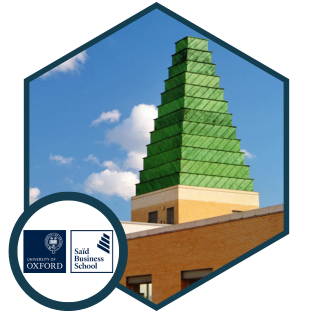The Challenge
Saïd Business School (Oxford Saïd) is the business school of the University of Oxford in England (the number one ranked University in the Times Higher Education University World Ranking).
It serves as the centre of learning for undergraduate and postgraduate students in business, finance, and management. Saïd has emerged as a prestigious institution, renowned not only in the United Kingdom but also throughout the world. “We want our students to lead with purpose, and create the next generation of social entrepreneurs who positively impact the world,” said Mark Bramwell, the Chief Information Officer for Saïd Business School.
Oxford students and faculty used the University’s homegrown virtual learning environment (VLE), WebLearn, for many years. However, administrators received feedback that the VLE was difficult to access, had a congested interface, and presented problems when it came to integrating outside applications and other digital tools.
The University identified the need for a more userfriendly, intuitive, and robust VLE during a Digital Education Strategy implementation consultation.
The Decision
In the summer of 2017, and as part of its competitive selection process, Oxford Saïd went through a trial of the Canvas VLE by Instructure.
With overwhelmingly positive feedback, decision makers realised that Canvas would not only support teaching and learning at the University, but also open the door to a world of new possibilities. “The flexibility and feature richness of Canvas gave us more capability,” said Bramwell. “Investment in technology can show your institution as being forward-thinking and willing to innovate. That’s exciting for students and potentially an important part of their decision-making process.” The University announced in 2018 that it selected Canvas as its new VLE.
In conjunction with its Canvas adoption, Oxford Saïd also started using Construct, a joint service offering from Proversity and Instructure that provides a full suite of bespoke creative learning design, production, and course design.
The Saïd Business School project team used Construct to accelerate their migration of eleven degrees, nearly one hundred modules, and several thousand pages of content.
To support our students, the technology has to be robust, reliable, and innovative. That’s what Canvas is.
Mark Bramwell
CIO, Saïd Business School, University of Oxford
The Results
The merger of Canvas, Construct and Saïd Business School follows the University’s goal of having the right resources embedded within an organisation that is a true, value-adding partner. Bramwell said, “In using Construct, it is clear what we wanted to achieve: agile project delivery whilst maintaining the quality standards of Oxford. We’ve had remarkable results.”
Oxford Saïd wanted to make technology simpler to use, as well as more engaging and more dynamic because that is what new students have come to expect and demand from elite institutions like Oxford. Now, administrators are using their new digital tools in new ways including pre-admission, student orientation, careerreadiness, and career fairs. They are also using the VLE in executive education to provide more collaborative and engaging distance learning for clients.
In evaluating their move to Canvas and use of Construct, Oxford Saïd say the project came in on time, under budget and with their expectations exceeded.
Bramwell said, “We want to exploit and leverage our investments in technology to the fullest for our students. Learning experiences are personal things and people look for the best and most intuitive tools to support this. Providing a world-class student experience is essential and with Canvas we believe we can do that.”
Key Findings
Initial implementation of Canvas VLE took just 42 days
Adoption of Canvas VLE and Construct allowed acceleration of degree programme migration (11 programmes, 85 modules) in 28 days
Number of service requests tickets to Oxford IT dropped by 80% since implementation of Canvas
Canvas scales to accommodate 1,000 new students each academic year
Favourite aspects of Canvas include mobile apps, intuitive interface, and customer support services
Download Case Study
